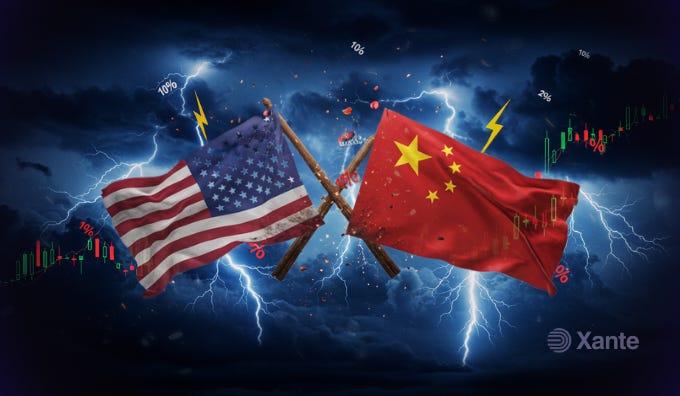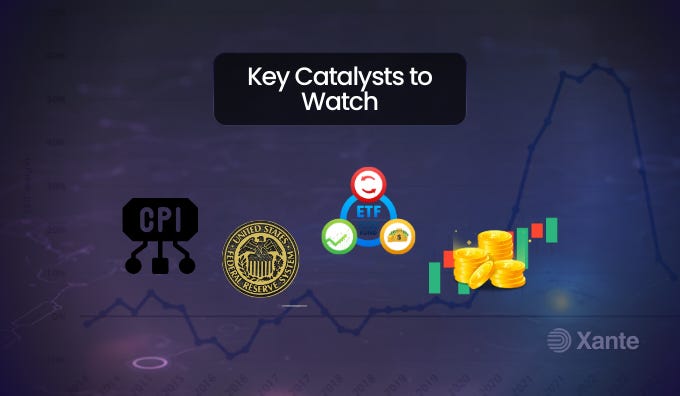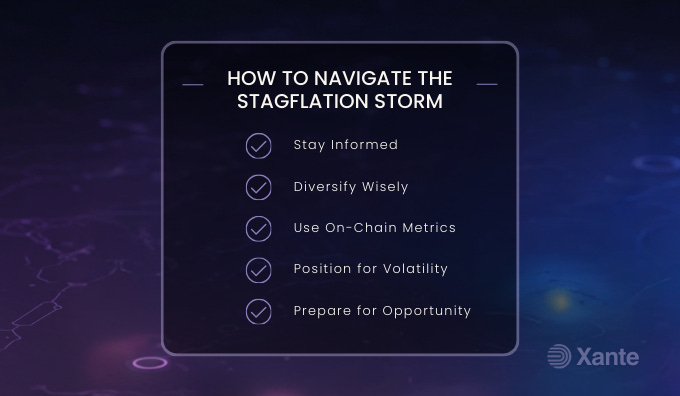Will Crypto Survive a Stagflation Storm? Tariffs, Rate Cuts & Bitcoin’s Identity Crisis in 2025
With inflation heating, a potential trade war brewing, and the Fed stuck between rate cuts and economic slowdown, the crypto market is at a major crossroads. Here’s a detailed look at the updates and what they mean for Bitcoin, altcoins, and your portfolio.
This article includes insights and data referenced from Binance Research.
Can Bitcoin Still Be Your Hedge in a World Spiraling Toward Stagflation?
What if the biggest threat to your portfolio isn’t volatility, but indecision from the Fed, policymakers, and the global economy?
Welcome to another gripping week in the world of crypto and macroeconomics. From spiking inflation fears to intensifying trade wars, the global financial landscape is shifting fast and crypto is caught in the crosshairs.
This blog post dives deep into the latest macroeconomic updates, Bitcoin’s shifting market behavior, and how rising protectionism and a potential stagflationary spiral are reshaping the future of Web3 and digital assets. Whether you’re an investor, builder, or curious bystander, this piece helps you make sense of what’s happening and what to do about it.
1. Macroeconomic Earthquake: Inflation, Trade Wars & the Fed’s Dilemma
“The tariffs announced in recent weeks are larger than expected, and their economic effects particularly on inflation and growth will need to be closely monitored.”
— Jerome Powell, April 4, 2025
Inflation is Back and It’s Angry
New tariffs have effectively raised import taxes across a wide range of consumer goods, sparking fresh inflationary pressure just when the Fed was beginning to breathe easy. According to market-based indicators:
1-year inflation swaps have surged past 3%
Consumer surveys now show inflation expectations as high as 5%
This means the average household is bracing for significantly higher prices on everyday items from electronics to groceries adding fuel to a fire the Fed thought it was putting out.
Stagflation is No Longer a Distant Fear
With tariffs adding costs and global trade friction escalating, economists are now warning of stagflation, a scenario where inflation keeps rising while economic growth stalls. A full-scale trade war could:
Wipe out $1.4 trillion in global output
Cut U.S. real GDP per capita by nearly 1%
Force some major economies into recession.
Real-world example:
Think back to the 1970s oil crisis, when energy prices spiked, growth slowed, and inflation spiraled crippling economies. That’s what economists fear could be repeated, only this time with supply chains and tariffs at the center.
2. The Fed’s Tightrope Walk: Cut Rates or Fight Inflation?
Just weeks ago, the Fed was focused on curbing inflation, signaling that rates might stay higher for longer.
Now?
Markets are pricing in rate cuts, not hikes.
Here’s Why That’s a Big Deal:
If the Fed cuts rates too soon, inflation could spiral out of control.
If they stay hawkish, it could deepen an economic slowdown.
This creates a lose-lose policy trap. The market knows it. The Fed knows it. And crypto? It’s reacting violently.
3. Crypto in Crisis Mode: Volatility, Correlation, and Capitulation
Crypto’s Reaction Has Been Brutal:
Bitcoin dropped 19.1%
Ethereum tumbled over 40%
Memecoins and AI tokens saw drawdowns of 50%+
ETH volatility surged above 100%
“This isn’t just a market dip, it’s a response to a full-blown macro panic.”
Crypto is behaving like a high-risk tech stock, not a hedge against inflation. Why? Because short-term macro fears are overpowering long-term narratives.
4. What Happened to Bitcoin’s Safe Haven Narrative?
Correlation shifts tell a compelling story:
BTC’s 30-day correlation with equities jumped from 0.32 to 0.47 (i.e., it’s now moving with stocks again)
BTC’s correlation with gold fell to 0.22 (a sharp drop from its previous neutral-positive stance)
This suggests that in risk-off environments, crypto is dumped alongside equities, rather than embraced as a hedge.
But it’s not all doom.
Long-Term Holders Are Staying Strong
Despite the volatility, on-chain data shows:
Long-term Bitcoin holders are not capitulating
BTC supply held for 1 year+ continues to rise steadily
Real-life parallel:
During the March 2023 banking crisis, Bitcoin decoupled from equities and rallied even as banks crumbled. Could we see that again?
5. The Bigger Picture: Crypto in a Stagflationary, Protectionist World
If this macro environment persists, crypto faces a uniquely complex challenge.
What Could Go Wrong:
Retail flows could dry up
VC funding may decline
Institutional interest could stall
But there’s also a silver lining.
What Could Go Right:
If the Fed cuts rates while inflation remains high, Bitcoin may regain its “hard money” status
Tariff-induced dollar volatility could renew BTC’s appeal as a non-sovereign store of value
New narratives like BTC ETFs, global adoption, and sovereign reserves may reassert crypto’s independence
Key Catalysts to Watch
Keep your eyes on the following developments:
Tariff escalations or relief (U.S.–China news will move markets)
CPI and PCE inflation data
Global growth indicators (e.g., PMI reports, labor market stats)
Fed rate decisions and commentary
Crypto-native catalysts like spot ETF approvals or new regulation
Key Takeaways
Macro Risk is Real: Trade wars and inflation are pulling crypto back into risk-asset territory.
Bitcoin’s Role is Evolving: BTC is currently acting like a tech stock, but history shows it can decouple during crises.
Volatility ≠ Weakness: Long-term holder conviction remains strong even during high volatility.
Diversification Still Matters: Crypto should remain one part of a broader portfolio, not the only bet.
Adopt a Macro-Aware Strategy: In 2025, understanding economic policy is just as important as understanding tokenomics.
Future Outlook: Will Bitcoin Rise from the Tariff Ashes?
Looking ahead, much hinges on the Fed’s next moves.
If they cut rates too aggressively, crypto could benefit from liquidity-driven rallies, especially if inflation remains persistent. Think of it as a throwback to the 2020–2021 QE era, where BTC soared under loose monetary policy.
On the flip side, if stagflation grips the economy and the Fed stays tight, risk assets including crypto may remain suppressed for months.
Adoption Metrics to Watch:
Global crypto ownership: Currently sits at ~420 million users (Triple-A data)
Institutional inflows: Watch for renewed fund activity if ETF approvals or regulatory clarity improve
Real-world use cases: Growing use of stablecoins in cross-border payments could strengthen crypto’s case
Actionable Step
Stay Informed: Monitor CPI data, Fed speeches, and major trade announcements weekly.
Diversify Wisely: Don’t go all-in on altcoins. Stick with conviction assets like BTC and ETH.
Use On-Chain Metrics: Track long-term holder supply, exchange outflows, and realized cap to gauge sentiment.
Position for Volatility: Use protective stop-losses, hedges, and dollar-cost averaging.
Prepare for Opportunity: Major dislocations often create once-in-a-cycle buying opportunities.
Conclusion: A Pivotal Moment for Crypto Investors
The world is shifting. Inflation is back. Trade wars are heating up. And central banks are stuck.
But amid the noise, the fundamentals of crypto haven’t changed. Bitcoin still offers an alternative monetary system. Ethereum still powers a decentralized internet. And the promise of Web3 is still intact.
What has changed is the urgency to be informed, macro-aware, and strategically diversified.
Let’s navigate this stagflation storm together. Your future portfolio will thank you.
For daily updates, follow us on all socials; Instagram, Twitter, Telegram, and TikTok. Subscribe to our newsletter for expert analysis to get weekly crypto insights, trend breakdowns, and smart investment takes delivered straight to your inbox, and join our WhatsApp channel to continue the conversation.
This article is for educational purposes only and should not be considered financial advice. Always conduct your own research (DYOR) before making any investment decisions.






